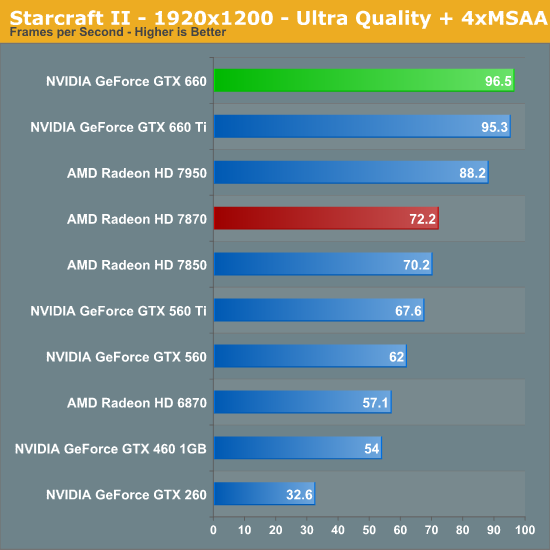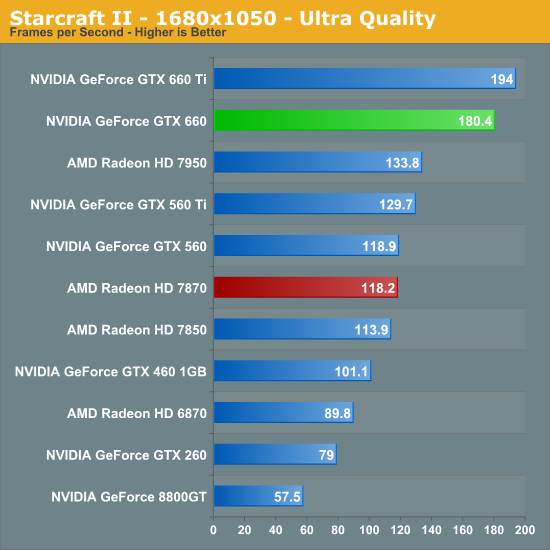The NVIDIA GeForce GTX 660 Review: GK106 Fills Out The Kepler Family
by Ryan Smith on September 13, 2012 9:00 AM ESTStarcraft II
Our next game is Starcraft II, Blizzard’s 2010 RTS megahit. Much like Portal 2 it’s a DX9 game designed to run on a wide range of hardware so performance is quite peppy with most high-end cards, but it can still challenge a GPU when it needs to.


With the release of patch 1.5, Blizzard turned both our Starcraft II testing methodology and our Starcraft II benchmark results on their heads. After straightening things out a curious pattern emerged: NVIDIA’s cards came out relatively unscathed, while most AMD GCN cards have taken a small performance hit compared to our earlier results. As a result Starcraft II now favors NVIDIA’s cards even more so now than it did before, making this an easy win for the GTX 660. At 1920 the GTX 660 beats the 7870 by 37%, and once more even the 7950 falls behind.
The driving factor here seems to be ROP performance, as showcased by the performance of the GTX 660 relative to that of the GTX 660 Ti. This is a textbook case of the GTX 660’s slightly higher ROP performance giving it an equally slight performance advantage over the GTX 660 Ti, and also explaining why performance hasn’t dropped to near-7870 levels like we’ve seen in some other games. With the next Starcraft II chapter already in beta testing, it will be interesting to see if these kinds of performance differences will remain into the future.










147 Comments
View All Comments
Margalus - Thursday, September 13, 2012 - link
you say the stock 660 looks bad when compared to an overclocked 7870? what a shock that is!I guess it's always fair to say an nvidia card is bad when comparing the stock reference nv card to overclocked versions of it's nearest amd competitor..
Patflute - Friday, September 14, 2012 - link
Be fair and over clock both...poohbear - Thursday, September 13, 2012 - link
well after reading this im still have with my Gigabyte OC gtx 670 i got 2 months ago for $388. I will NOT be upgrading for 3 years & im confident my GTX 670 will still be in the upper segment in 3 years (like my 5870 that i upgraded from), so @ $130/yr its a great deal.poohbear - Thursday, September 13, 2012 - link
erm, i meant i'm still happy*. sucks that u can't edit on these comments.:pKineticHummus - Friday, September 14, 2012 - link
i had no idea what you meant with your "im still happy" edit until I went back to read your original statement again. somehow I mentally replaced the "have" with "happy" lol. reading fail for me...distinctively - Thursday, September 13, 2012 - link
Looks like the 660 is getting a nasty little spanking from the 7870 when you look around at all the reviews. The GK 106 appears to loose in just about every metric compared to Pitcairn.Locateneil - Thursday, September 13, 2012 - link
I just built a PC with 3770K and Asus Z77-v Pro, I was think to buy GTX 670 for my system but now I am now confused if it is better to go with 2 GTX 660 in SLI?Ryan Smith - Friday, September 14, 2012 - link
Our advice has always been to prefer a single more powerful card over a pair of weaker cards in SLI. SLI is a great mechanism to extend performance beyond what a single card can provide, but its inconsistent performance and inherent drawbacks (need for SLI profiles and microstuttering) means that it's not a good solution for when you can have a single, more powerful GPU.knghtwhosaysni - Thursday, September 13, 2012 - link
Do you guys think you could show frametimes like techreport does in your reviews? It can show some deficiencies in rendering that average FPS doesn't, like with Crysis 2 http://techreport.com/review/23527/nvidia-geforce-...It's nice that techreport does it, but I think Anandtech is the first stop for a lot of people who are looking for benchmarks, and I think if you guys showed this data in your own reviews then it would really push AMD and Nvidia to iron out their latency spike problems.
Ryan Smith - Friday, September 14, 2012 - link
We get asked this a lot. I really like Scott's methodology there, so if we were to do this I'd want to do more than just copy him by finding some way to do better than him (which is no easy task).To that end I find FRAPS to be at a higher level than I'd like. It's measuring when frames are handed off to the GPU rather than when the GPU actually finishes the frame. These times are strongly correlated, but I'd rather have more definitive low-level data from the GPU itself. If we could pull that off then frametimes are definitely something we'd look in to.